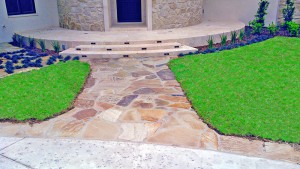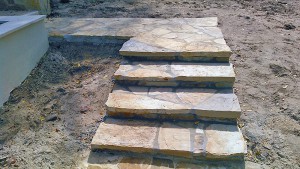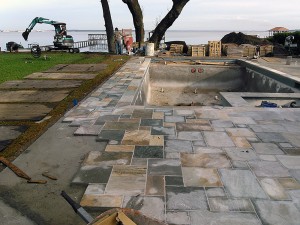
EK Birken Masonry has extensive experience working with landscaping contractors to develop customized paver paths and patios. Our experience includes pavers that are of regular or irregular shapes and dimensions. The thickness of pavers depends on the type and strength of the stone, on the designed sizes, and on the nature of the support. Exterior pavers are usually larger than 2′ square in size and their thickness can vary from 1- 1/4″ to as much as 4″ depending on the intended use. As a rule of thumb, the cement mortar bed should more or less equal the thickness of the stone paver. No air pockets should be left under any of the pavers installed in a cement mortar bed. The use of lime in the cement mortar bed is NOT recommended. Application of any plaster of Paris for any part of the exterior flooring will be detrimental.
Design of joint width for exterior pavers may vary from a minimum of 1/8″ to 1/2″, using cement mortar or polymeric sand. In case of cement mortar, expansion joints should be introduced approximately every 25 feet. The use of wire-mesh reinforcing in the setting bed, and a slip sheet under the setting bed, is a matter of design consideration.

Interior stone pavers installed on a wood structure on top of plywood need special treatment because movement of the wood structure must be anticipated. To prepare more rigid support, the use of two layers of plywood is recommended, with the plywood joints not lined up with one another, but staggered. Bituminized felt paper and galvanized wire mesh should be tacked down to the double plywood floor and not less than a 1-1/2″ thick mortar bed should be prepared using a mixture of 1 bag portland cement and 3 cubic feet of clean sand, mixed with 3 gallons of Laticrete or approved equal of latex admixture.
Before placing the stone floor tiles on a wet screed bed, an approximate 1/16″ thick latex-based skim coat shall be applied to the back of each floor tile. Uniform joints of not less than 3/32″ wide shall be maintained. After each piece is laid, it shall be tapped down using a wooden block to level the surface and imbed the stone. Care must be taken not to crack the floor tiles during the tapping. Joints are filled with portland cement with or without latex reinforcing and sealed with a squeegee. Movement joints shall be applied between the walls and the floor tiles.

For exterior pavers the use of a sand bed may be considered. Pavers installed with a sand-set method can easily be replaced, repaired, or adjusted. However, the sand-set method shall be used only with soil conditions that drain well and are stable with no settling. Proper compaction of a well-draining sub-bed and sand setting bed is critical to prevent settling and moving. For stability, a maximum 1″ thick sand bed should be used with 1/16″ wide joints that are swept with sand. The sand set method is NOT recommended for interior use.
